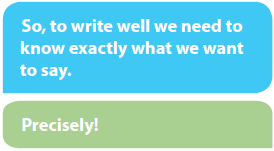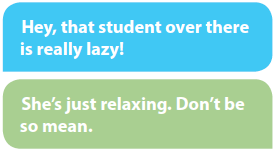In strong writing, ideas are expressed with precision. To do this, you need to be very sure in your mind about what you want to say. Unclear ideas can be the cause of unclear writing, with weak transitions, over-generalizations, and skewed connotations. To fix these writing challenges, you may find that you must refine your thinking about the topic as well.

In this workout, you will practice three strategies for making your writing more precise:
- Use effective transition language
- Use specific and concrete language
- Use appropriate connotation
Let’s get started.
Use Effective Transition Language
Example:
 |
Students like to use social media. Instagram is one kind of social media. Users post photos to Instagram. |
 |
Students like to use social media such as photo-based Instagram. |
Problem:
When you write without transitions, it’s like leaving out road signs and traffic lights – the reader doesn’t have any clues on how to navigate the information. When this happens, the reader must fill in the missing clues, and this can lead to confusion and miscommunication. In this case, the relationship between the different ideas is not made clear.
Fix the problem:
By combining information, you can highlight the relationship between the ideas. In the example, Instagram is given the adjective photo-based and is positioned as an example of social media.
Here’s another example:
 |
Using social media like Instagram is fun. Students use it to connect with friends. Students must learn the risks of using Instagram. Photos on Instagram can sometimes be embarrassing. |
 |
Using social media like Instagram is fun. For example, students use it to connect with friends. However, students must learn the risks of using Instagram as photos posted there can sometimes be embarrassing. |
Problem:
The four distinct ideas in this example are too complicated to be combined into one sentence. But, the problem of the relationship between them remains; we are counting on the reader to fill in the implied relationships between these sentences. Why take that risk? Make the writing precise.
Fix the Problem:
It’s amazing how powerful small words can be! Use transition language to make connections between the ideas. The second sentence is an example to illustrate the first – so we inserted “For Example.” The third sentence seems to add a condition to the first sentence, and so we added “However” to indicate there is a limitation to the fun of Instagram. The final sentence explains the risks, and so we used “as.”
Remember, while our example may look simple, clear transition words become much more important as the ideas, sentences and vocabulary in your writing become more complex.
Use Specific and Concrete Language
Example:
 |
Video games are bad for children. |
 |
Excessive video game play can have negative effects on children’s health. |
Problem:
If the vocabulary we choose is too general, we lose the complexity and precision of our ideas. Sometimes we rely on general or vague vocabulary because we are rushing to finish an assignment, and sometimes this happens when our ideas are not fully developed.

Fix the Problem:
Attention to precise vocabulary makes writing specific instead of general. We need language that represents the depth and detail of our ideas.
Use Appropriate Connotation
Example:
 |
That student is really lazy. (negative connotation) |
 |
That student is relaxing. (positive connotation) |
Problem:
Language has both denotative meaning (the dictionary definition) and connotative meaning (the social or cultural definition). Your writing can be misunderstood if you fail to consider the connotative meaning of words. This can be particularly challenging if English is not your first language.
Fix the Problem:
Be mindful of the language that you choose for your ideas and ensure you have the right positive or negative connotation.

